The US Presidential election is due for later this year. With improved ties between India & the US, the interest in the 2020 US elections is more than ever. But how does the election for the US President take place? Here is a detailed explainer.
Every leap year not only marks the global sporting spectacle of Summer Olympics but also is the year of United States of America’s (USA) Presidential Elections. The President of USA serves for a 4-year term and barring the first election in 1789, the US presidential elections coincided with the leap year.
The global standing of United States and the soft power it holds makes US presidential election a keenly watched event with considerable international impact. In the last two decades, the relations between India & USA have improved and many Indian expats are in influential positions in the USA. All these developments have ensured that the 2020 US Presidential election will be a keenly watched one in India.
While the actual election is scheduled for 03 November 2020, there is a frenetic pre-election activity that is already being witnessed in the early months of this year, especially with the Democratic Primaries. The entire idea of an extensive pre-election activity across the country to seek party’s nomination as the Presidential candidate does look alien from an Indian context.
So, what are the primaries? How does USA elect its president? Does it have any similarity with the election process in India? We explore these and related aspects regarding US Presidential elections in this explainer.
Only a natural born US citizen can become President of USA
One has to be a natural born US Citizen to be able to become the president of USA. A natural born citizen refers to anyone who is a Citizen of USA at the time of birth.
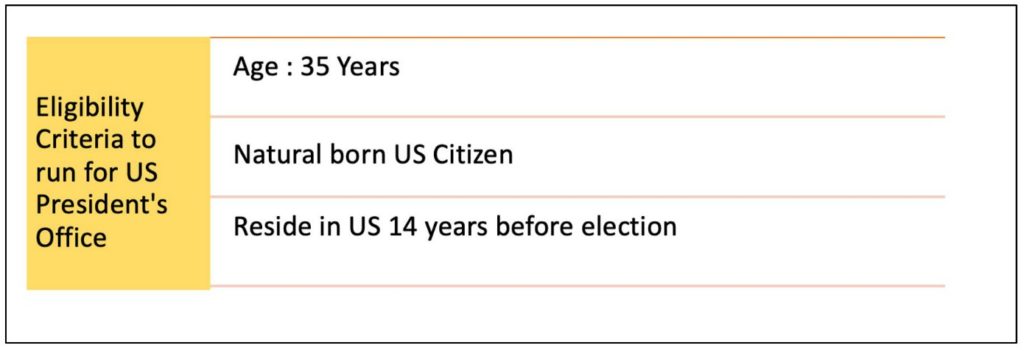
Two phases in the US Presidential Election cycle
The presidential election process in United States takes place in two phases. The first phase of voting is to determine the party’s nominee for president. This happens through caucuses and primaries that take place across the different states. The second phase is the general election, which takes place on a designated day (03 November for this year’s election) across the country.

Primaries and Caucuses determine the nominee of various parties
The political landscape of United States is dominated by two political parties, the Democratic Party and the Republican Party. During the initial phase of the electoral process, both the parties go through Primaries and Caucuses to elect their nominee who would be contesting on the party ticket for the post of President of United States (POTUS).
The president is restricted to two terms in office as per the 22nd amendment of US Constitution.
In most cases, the current President who is serving his/her first term is the party’s nominee to run for the president. In such a case, the primaries of that party are not a much-contested event.
- For example, for 2020 elections, the current president Donald Trump, who represents Republican Party is contesting for re-election to second term. Hence the Republican Party primaries this time around aren’t prominent. On the other hand, Democratic Party primaries for 2020 are not only competitive but also much talked about as they have to identify their nominee who would be contesting against trump.
- In the previous election (2016), both the Republican and Democratic primaries were serious events because both the parties had to identify their nominees for the Presidential election. Barack Obama of Democratic Party, who was the then president was in his second term and hence could not contest for a third term.
Caucuses & Primaries
Caucus & Primary are two ways by which different states elect the nominee for the presidential contest. Caucuses are organized by political parties. These are held at county, district and precinct levels where the participants divide themselves into groups according to the candidate they support. Each of the group give speeches, discuss and try to influence others in respect to the support of their candidates.
On the other hand, in a primary election, individual voters are required to go to respective polling booth and cast their vote. The voting is done through a secret ballot. The way these primaries are conducted are subject to respective state laws and vary from state to state. Broadly there are two types of primaries, closed & open. Some states follow a semi-open system as well. In the closed ones, only the voters registered with a particular party can vote in the primary. This deters voting by members of other party or individual unaffiliated voters. In the open primary, all the registered voters as well as unaffiliated have an option to choose the primary of any party to vote.
The following table shows which of the states follow the Caucus and which ones follow the primary model. There could be minor changes to these depending on the party.
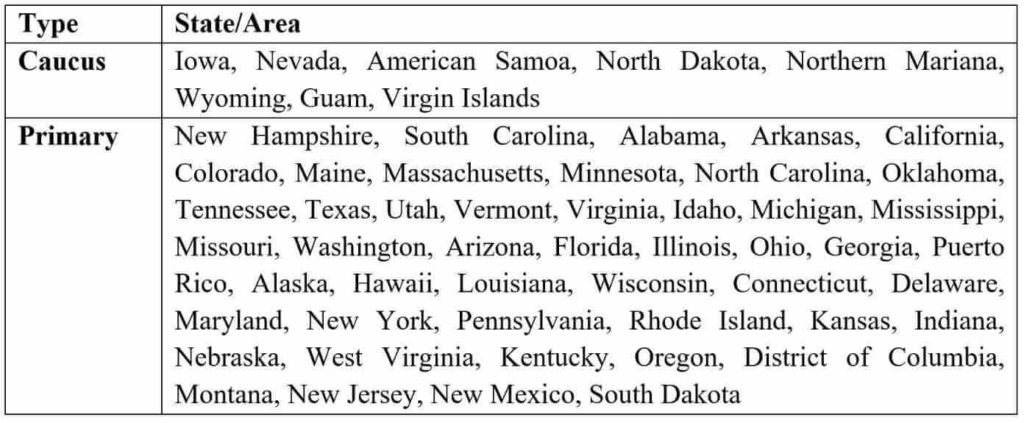
The conduct of Primary elections varies from state to state
Winning the primary elections is a key step for any candidate to gain the nomination for presidential election. These primaries are organized by respective states and local authorities.
Eligible candidates can nominate themselves to contest in the primary elections.
The primaries are conducted on different dates with traditionally New Hampshire being the first state to conduct primaries. Based on the votes polled by each of the candidates, delegates are awarded to the candidates. The rules for awarding the delegates differ for Democratic and Republican parties and from state to state. Democrats usually use a proportional method while it is more varied among the states in case of Republican primaries.
In the case of a caucus, the votes at the end of the caucus determine the number of delegates won by the candidates. The election season generally kicks off with Iowa Caucus.
Number of delegates won by members in both the primaries & caucuses are known as pledged delegates, which means they have to vote for the candidate that won, at the national convention.
Primaries for State Elections
In addition to the presidential election primaries, the state level elections in the USA also follow a primary system. There are 6 different types of primaries opted by each of the states with Louisiana and Nebraska having their own way of conducting primaries as far as state level elections are concerned.
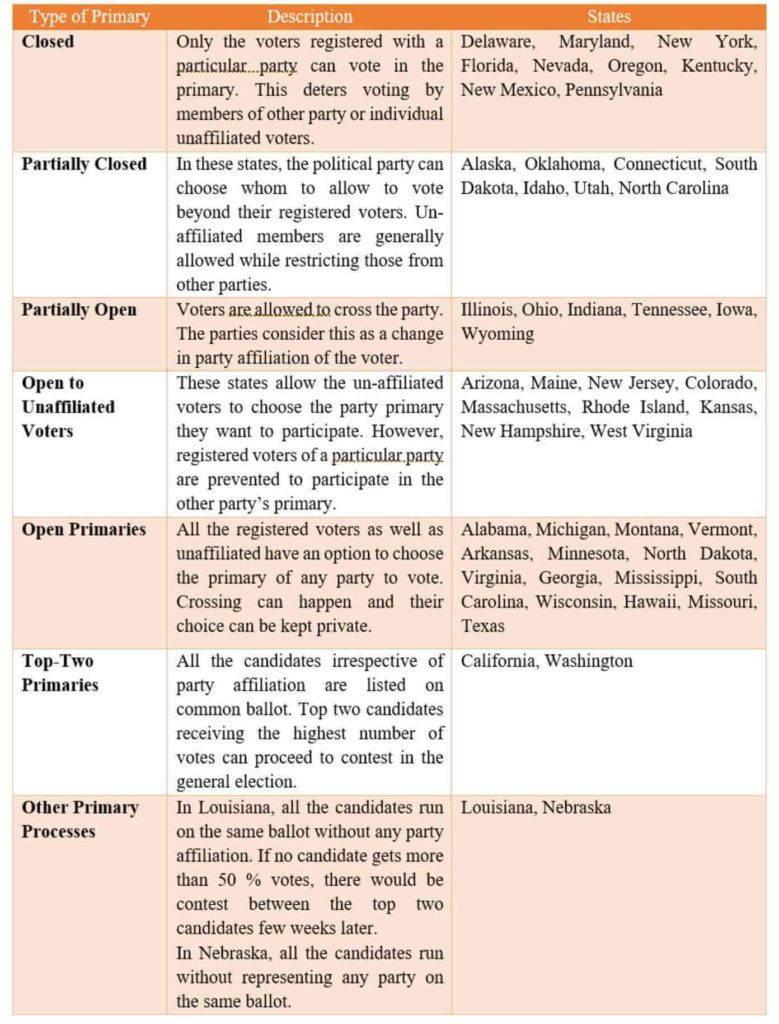
Who are Super Delegates?
Apart from the pledged delegates that are awarded to the contesting candidates of both the parties through primaries and caucuses, each of the parties also have something known as ‘Super Delegates’. These super delegates are higher ranking officials of the respective parties and are generally unpledged to any of the candidates prior to National Convention. They have the option to vote during the National Convention to determine the Presidential Nominee
The criteria vary between Republican & Democratic Party.

The National Convention to choose the nominees
The Democratic National Convention (DNC) is an event in which delegates of the Democratic Party choose the party’s nominees for president and vice president. For any candidate to win the democratic party nomination, they will need 1,991 of the 3,979 pledged delegates at the DNC. If none of the candidates wins the required number of pledged delegates, then the super delegates come into picture. More about how this works can be read here.
For 2020, Democratic Party has banned the voting of Super Delegates at the first round of the national convention. In other words, they come into picture only when a candidate does not have the required number of pledged delegates. This change is made in view of the criticism that voting of Super Delegates favours the traditional candidate.
On the other hand, any Republican party candidate needs 1276 of the 2550 pledged delegates to win the nomination.
The National Convention is organized by each of Democratic and Republican party to finalize on the Presidential Nomination of their party. As per the general rules, the clear-cut winner of the primaries who could have received the highest number of delegates from the primaries wins the nomination. Hence the National Convention becomes a platform to officially ratify the presidential candidate of the respective party.
If there are multiple rounds of voting was required during national convention to determine the presidential candidate, such a National Convention is called as “Contested Convention”. Once a candidate receives the presidential nomination from the Party, he/she can choose their Vice-Presidential nominee, colloquially referred to as Running Mate.
President gets elected through the Electoral College
Unlike the other elections in the United States, the President does not get elected directly through the popular vote. An Electoral College determines the winner in the presidential race.
The Electoral College is considered to be a compromise between the proposition of electing through popular vote and election by Congress.
Article II of the constitution refers to ‘Electors’, although there is no mention of Electoral College in US Constitution. This is further supported by 12th Amendment.
The Electoral College consists of 538 members. The number of votes allocated (electoral college members) to each state is proportional to the population of the respective state. A candidate should receive minimum 270 Electoral college votes to be the winner. The number of electoral college members from each state is in the map below.

What is the Election Process?
- Each Presidential Candidate selects his/her own group of electors (electoral college members) in each state prior to the elections. This group is referred to as ‘Slate’.
- On the General election day, which is generally the Tuesday after the first Monday in November, the voters take part in a secret ballot to vote for the presidential candidate of their choice.
- However, voters are actually voting to choose the respective electors (electoral college members) in the state.
- In most of the states, ‘Winner -takes-all’ system is followed where in all the Electoral College Votes of that state are given to the candidate winning the popular vote in that particular state. For instance, the candidate who wins the popular vote in California gets 55 electoral college votes.
- Nebraska & Maine are exceptions where in the State winner receives two electors and the winner of each congressional district receives one elector.
- After the General Elections, the respective State Governor prepares a Certificate of Ascertainment which lists the names of the Electors representing the State.
- On the designated day (First Monday after Second Wednesday in December) , the electors meet in the respective states and vote for President & Vice-President candidates.
- Although there is no constitutional provision which prevents the electoral college member to vote for a different candidate contrary to the popular vote, each state has separate laws to deal with such situation.
- These votes are counted in joint session of US Congress on 06 January and the new President & Vice President elect are declared.
- The president elect is takes oath to office and sworn in as President of United States on 20 January 2020.
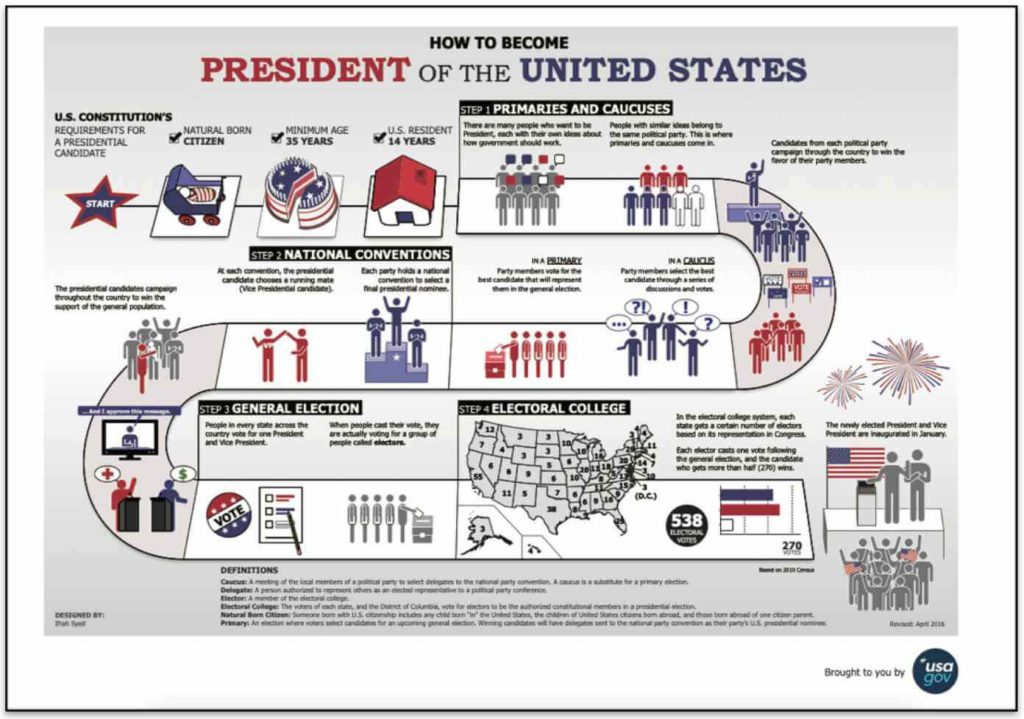
(Reference : How to Become President of United States –Infographic)
The one who wins the Popular vote may not always be the winner
One of the drawbacks in the electoral college system is that it is possible for a candidate to win the popular vote across the country but still lose the presidential election because of the electoral college system.
For instance, in the 2016 presidential elections, Hillary Clinton won the popular vote across the country with 48.18% votes while Donald Trump polled 46.09%.

Though the difference in popular vote was more than 2%, Donald Trump won convincingly through the electoral college system by winning 304 electoral college votes compared to 227 for Hillary Clinton.
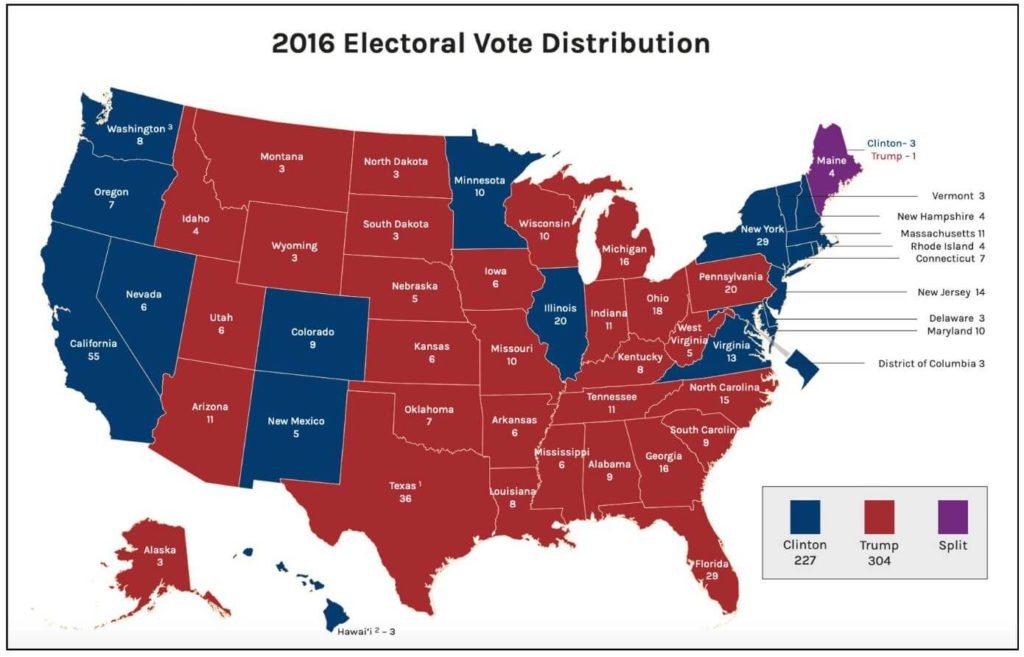
Similarly in the year 2000, Democratic candidate Al Gore won the popular vote while Republican George W.Bush won the Electoral College.



